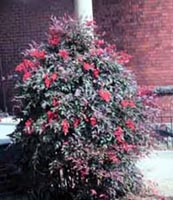Resource Library
Plant of the Week: Heavenly Bamboo | Nandina bushes in Arkansas
The University of Arkansas System Division of Agriculture does not promote, support or recommend plants featured in "Plant of the Week." Please consult your local Extension office for plants suitable for your region.
Plant of the Week
Heavenly Bamboo or Nandina Bush
Latin: Nandina domestica

I’ve always liked nandina. In fact, my first college paper on a plant way back when,
was on this shrub.
But landscape fashions change and the popularity of this venerable shrub seems to
come and go as new or more exciting plants appear on the scene.
Nandina is a shrub of the South. The English garden books mention it, but only in
passing because to achieve its full glory it must have the summer heat only we can
provide. In the South, nandina is one of our signature plants, because once it is
established it will persist almost indefinitely.
The standard nandina is a multi-trunked shrub to 6 feet tall with much of its doubly
and triply compound leaves attached at the top, giving the plant a bamboo-like appearance.
It is not a bamboo but actually related most closely to the barberries.

The nandina clump spreads slowly by means of an underground root system and can eventually
occupy a space three or more feet across. Clusters of showy white flowers appear in
late spring and are followed by dense pea-size red berries which persist through the
winter until the plant flowers again in the spring. The berries do not seem to be
much preferred by birds. In the winter the leaves take on varying shades of red, maroon
and green in a most appealing fashion.
Nandina is native to southwestern China where it has been cultivated since at least
the Tang Dynasty of the 6th Century. It was introduced into Japan possibly as late
as the 1600s and the first descriptions to Western science were from there. In fact,
the name Nandina is derived from the Japanese name Nan-din. The epitaph domestica,
is from the Japanese custom of planting the shrub near the front door of the house.
If a family member were to have a bad dream, all ill effects could be avoided by confiding
the dream to the Nan-din upon arising.
The Chinese, and to large measure the Japanese, do not favor our Western style of
gardening. While China is the home of 80 percent of our garden shrubs, only a relatively
few of these are used in Chinese gardens. Nandina is one of the few chosen plants.
It is often used as an offering for altars and home shrines. In winter, cut nandina
stems are sold for the Chinese New Year celebration much as we sell holly branches
for Christmas.
Nandina was introduced to England in 1804 and probably made its way to the U.S. shortly
thereafter. It has been used extensively in southern gardens as a part of the foundation
planting where it often looks a bit top heavy because of its bare base and leafy top.
Most plants would benefit from having two thirds of the erect growing canes cut out
to expose the grace of the stems. But, don’t throw away the stems. They are said to
be the best toothpick wood available because of their delicate taste.
Nandina grows in full sun or light shade. It grows faster and bigger in good soil
than poor, but it will grow in either. Once established it is very drought resistant.
It seems immune to disease and insect attack except for possibly grasshoppers.
In northern parts of Arkansas nandina will occasionally freeze to the ground when
temperatures fall below minus 10 degrees Fahrenheit.
By: Gerald Klingaman, retired
Extension Horticulturist - Ornamentals
Extension News - November 12, 1999
The University of Arkansas System Division of Agriculture does not maintain lists of retail outlets where these plants can be purchased. Please check your local nursery or other retail outlets to ask about the availability of these plants for your growing area.